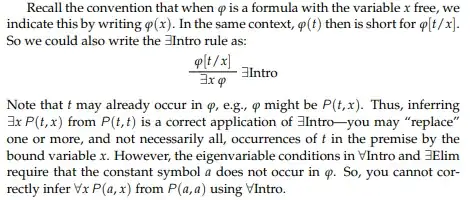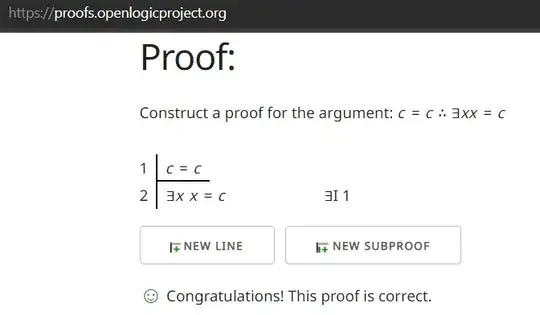As the question has unexpectedly taken an instructive turn, I need to revise my answer from beginning to end. I shall explain why Patrick Suppes' statement of the rule is not wrong, though his system might seem peculiar (well, he was an eminent philosopher at the end of the day), and why $\exists x(x=1)$ cannot be derived from $1 = 1$ at one step from EG-rule in his system.
This is the definition of the definition of existential introduction rule from the text of Open Logic Project (p. 276):

So, Suppes' definition is wrong and Open Logic Project's is right? No, neither one is wrong; if one gives the same input, one gets the same output from both of them, the difference resides in between. They are just different systems of proof that serve the same ends, each with its vices and virtues. A necessity is that one ought to absolutely keep in the system one has begun with all the way through, even if an obvious line appears counter-intuitively hard to derive.
In contrast to many contemporary books on mathematical logic, Suppes extensively offers verbal accounts merged with semantic considerations in a system with specific features. To see the relevant divergence in Suppes' system, it may be helpful first to examine a proof in a system that today's readership is more familiar. The proof is a modification of the one Allegranza has given as an answer using the system in H. Enderton's A Mathematical Introduction to Logic, since we have $1 = 1$ as a premiss at present ($y$ is substituted by $1$, see the referred answer for the annotations):
- $1 = 1$
- $\forall x\neg(x = 1)\rightarrow\neg(1 = 1)$
- $(1 = 1)\rightarrow\neg(\forall x\neg(x = 1))$
- $\neg(\forall x\neg(x = 1))$
- $\exists x(x = 1)$
Focus on the subformula $x = 1$. If $1$ is an individual constant of the language, this open formula can be readily constructed by the syntactic formation rules. Anyhow, it has to occur in some line. Because we need the statement '$x$ is $1$'; by themselves, '$x$ is $x$' or '$1$ is $1$' does not suffice in this system in order to derive $\exists x(x = 1)$. We'll see a similar requirement in Suppes' system.
The following are the relevant directions Suppes gives in the book:

(p. 85)

(p. 104)

(p. 104)
It should be remarked that Suppes defines open formulas as "formulas which have no quantifiers" (unlike the standard definition). Accordingly, we have not only the system-given open formula $y = y$, but also $1 = 1$ as the premiss. But how shall we proceed further? Given the EG-rule that dictates us a uniform replacement, the last rule seems of no use to deduce from $y = y$ and $1 = 1$ to $y = 1$ to conclude $\exists x(x = 1)$.
In Suppes' system, terms are divided into three classes: proper names, ambiguous names ("temporary constants", more on them below) and variables. The details of this system cannot be summarised here, but the key idea to proceed further is, assuming that $1$ is in the domain of discourse, again an introduction of a formula that says "... is $1$" (by a proper name $a = 1$ or an ambiguous name $\alpha = 1$).
We have seen that some systems demand an explicit designation like $x = 1$, some others do not and find it sufficient that a name exists in the language. Each proof system has a "design philosophy" behind it and authors have their individual concerns. However, even a cursory discussion of these is too far-fetching.
Let us consider the issue the OP rightly draws our attention to. On p. 78, Suppes says

Isn't it incoherent to derive the existential formula "immediately" given the EG-rule? This cannot be said to be incoherence, but an unfortunate result of Suppes' style dispersing the features of his system here and there in the book.
As mentioned above, Suppes describes a class of terms he calls ambiguous names to facilitate quantifier rules. He remarks in the preface that

An epsilon term $\epsilon xA(x)$ picks out some $x$ whose only characteristic is to satisfy $A(x)$. Employing this device with an ambiguous name $\alpha$, we replace $\frac{1}{2}$ in the formula
$\frac{1}{2}=\frac{1}{2}$, then
$\frac{1}{2}=\alpha$
since $\alpha$ is a name whose only defining property is to denote $\frac{1}{2}$. Thus,
$\exists x(\frac{1}{2}=x)$
follows. This is what Suppes calls "immediate", as I understand him.
Addendum
It may be useful to explicate the notion of ambiguous name a bit more. It is, in fact, a representation of a familiar device.
Consider a common phrase from mathematical discourse: "Let $\alpha$ be an even number, . . ." What is $\alpha$ here?
Suppes would respond like this: It is not genuinely a variable, it does not vary across a range of values as the argument of a function does. It is not a number name, either; it is not one of the names two, four, six, . . . It does not designate something properly, its status is ambiguous. Actually, it is a temporary number name we introduce to carry out our discussion and has no identity in itself beyond this.






